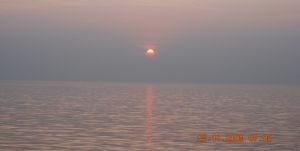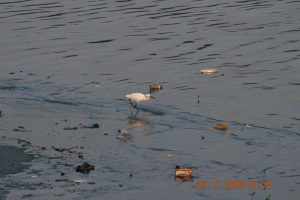The Sewri Mudflat is a relatively unknown attraction in the city of Mumbai. It is, however, well-known with the environmentalists, bird enthusiasts and wildlife photographers that come to watch large flocks of migratory birds coming to nest during October to March every year. One can see a big variety of birds; from the Kingfisher to the Sea Gulls, Sandpipers, Parakeets and of course the Greater and Lesser Flamingos! (A complete list is available here).
Last year, I was introduced to the idea of visiting the mudflats by a colleague who, driven by the sights & sounds and the fantastic photo ops, was a regular. So when a friend came calling for company, I instantly agreed.
I initially thought of the mudflats as some obscure place on the east coast of Mumbai. But after a few queries on Google, I found the route. All we had to do is to take the road directly opposite to the railway crossing near Sewri station on the east side, turn left at the garbage dump T-junction and finally a right to head toward our destination, the Sewri jetty. This area is littered with trucks and oil tankers. You will see a lot of storage depots of major petro companies here. The roads are riddled with potholes. But the good news is the Sewri Fort Road is getting concreted. So at least future trips won’t be so bumpy!
There are a couple of things you need to take care of; first, the right time to go is just a couple of hours before the high tide; second, bring a good binocular along. The reason for the first point is that as the tide comes in the birds start coming closer to the shore and then you can get a very good view.
My friend and I reached there at about 6:50 a.m. just before the sunrise. Perfect time to go; got to see the sunrise, avoid the harsh sun and the traffic. I was really surprised to see quite a few people there already, most of them photographer, clicking away at the birds. And the others were from the BNHS (Bombay Natural History Society). BNHS organizes such outings for bird watching so get in touch with them if you need some info to go with your trip.
We followed everyone atop one of the two junk ships lying around the jetty. As we climbed up, one of the most beautiful views hardly seen in Mumbai awaited us. We could see almost 2,000 Flamingos; most of them pink while the others were blackish brown. The pink ones were a little farther than the brown ones but every once in a while some of them would take flight and encircle us as if to help us a get a closer look and give us an opportunity to appreciate them.
After spending about an hour we decided to make a move. From the jetty we could see some trucks parked at a distance. This place was very close to the pink Flamingos. So we started walking in the direction of the trucks and reached the Sewri Fort. We decided to go inside the Fort (a protected monument but very badly restored) and see what we would find. The view from the top of the fort was awesome, just what we had expected, lots of pink Flamingos much closer than the jetty. I saw a local boy studying there and asked for directions to some place much closer than the fort. He promptly pointed out the Colgate-Palmolive factory. We were glad we took a detour and came here. Here we could not just see them but hear them too. I overheard a conversation where someone was trying to give gyan on what the sounds meant 🙂
One thing that really upset me was the pollution. I saw everything from chappals to an empty bottle of Nimbooz in the water topped off with a thin film of oil. I remember an article in a leading newspaper about the very high content of Mercury in these waters. The article also noted the futile attempts to rescue a flamingo with severe diarrhoea, bacterial infection and major bleeding from its mouth.
We talked to some regular visitors and came to know that the migration patterns of the birds have also changed. Their arrival time has become erratic and some of them don’t even come!
I suggest everyone should go visit these birds at least once before the pollution and development destroys this fragile ecosystem.
 |
| Bird Watching, Sewri Dec09 |










